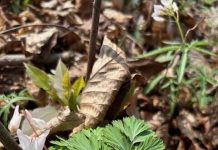Signs of life in the dead of winter:
Truly, truly, I say unto you.
Unless a kernel of wheat
falls into the earth and dies,
it remains alone, but if it
dies, it brings forth much fruit.
— John 12:24
Early in February, there was snow on the ground. I was walking on Cherry Street. I noticed on the side of the street one dead flower.
It was a sunflower. One dead and dry sunflower. But something about this dead sunflower grabbed my attention.
It was standing up straight and tall. In the ice and chill of a snowy February morning, one sunflower stood posthumously tall and straight. It was as if this sunflower were still standing in protest against the icy, silent grip of winter. Even the strong Indiana wind could had not brought her down.
Nobody had told the sunflower that she was supposed to start leaning near the end of summer. Nobody told her she was supposed to completely fall by December. Ms. Sunflower stood alone, against the odds. She was a symbol of defiance in the face of death.
That sunflower was a sign of life in the dead of winter. She reminded me of the Lenten season. Beginning several weeks ago, with Ash Wednesday, we started our march with Jesus. We started painfully parading toward “The Place Of The Skull” where legend says Adam’s skull was buried.
Yet, the cross that stood fierce, scowling on top of that hill, became the lever that Archimedes dreamed about, the lever by which God would move the world. Life was present in the midst of death, because God was present in the midst of death.
As I walked past that sunflower on a frigid February day, she reminded me of how the deadly cross became a sign of life.
The word “Lent” comes from a word that means “lengthen” — because the daylight lengthens as winter gives way to spring.
The Lutheran composer and poet Herbert Brokering once told me, “If we look closely enough, we can spot crosses everywhere.”
He pointed out that every crack in the pavement, every dry branch, every dead leaf can represent the cross. Brokering would be the first to note that crosses are necessary for new life.
The shell of the egg must break before the new life can emerge.
Valparaiso professor Walter Wangerin has published a book titled “Wounds Are Where Light Enters.” For some reason, a dry, dead sunflower reminded me of the truth discovered by Wangerin and millions of others through the centuries.
As we walk with Jesus, death loosens its cold grip on our hearts and souls. As we walk with Jesus, winter gives way to spring, the sun keeps on rising.
And hope springs eternal.
The Rev. Larry Isbell is pastor of First Lutheran Church in Columbus. He can reached at [email protected].




